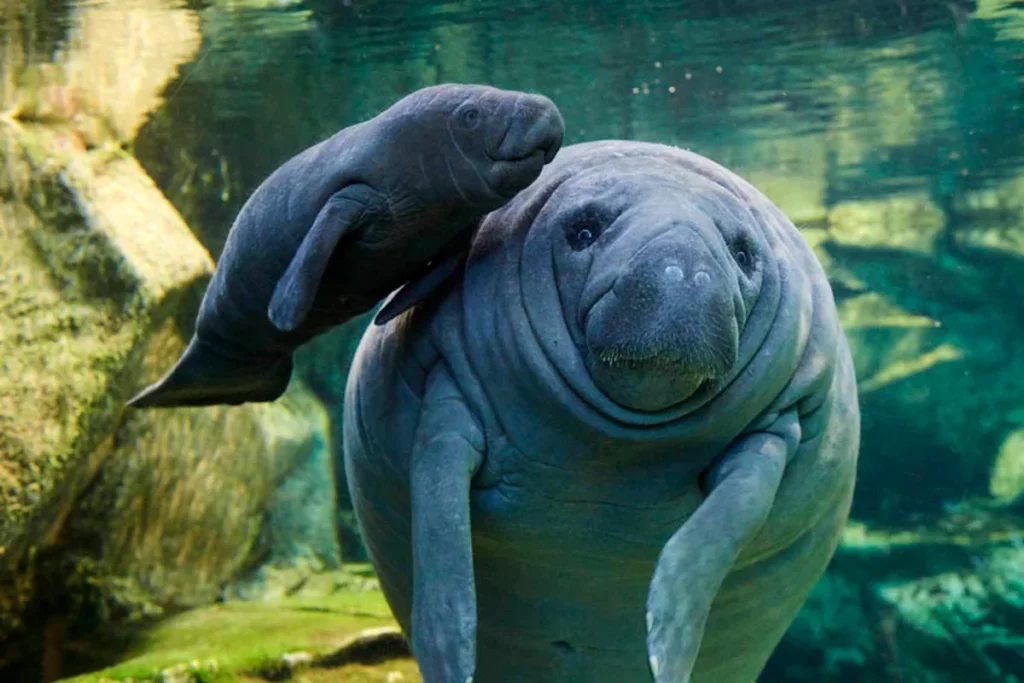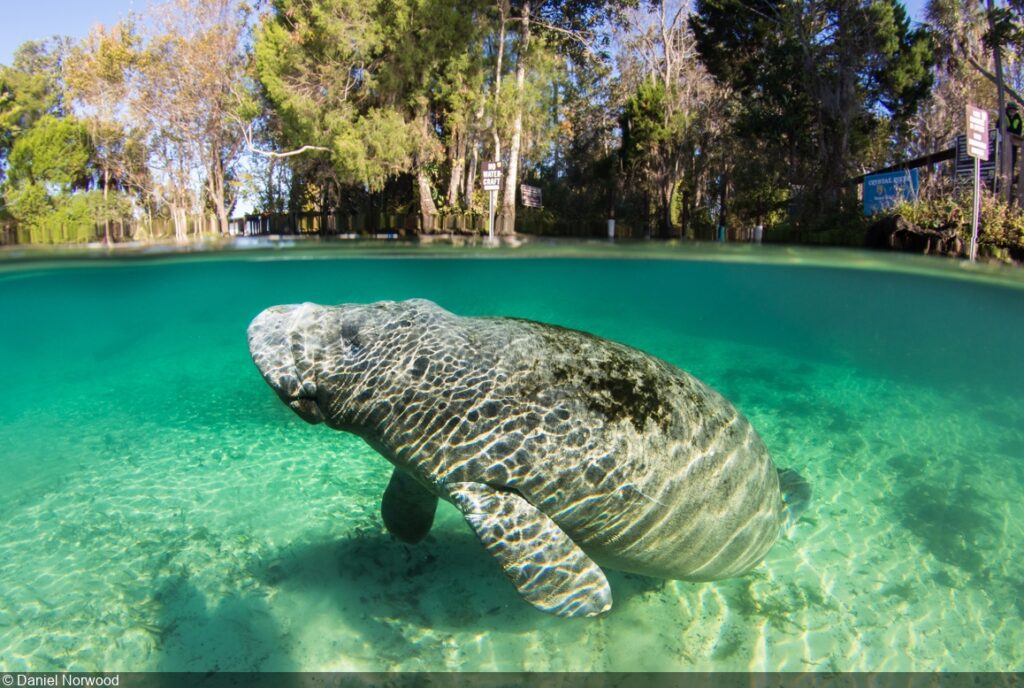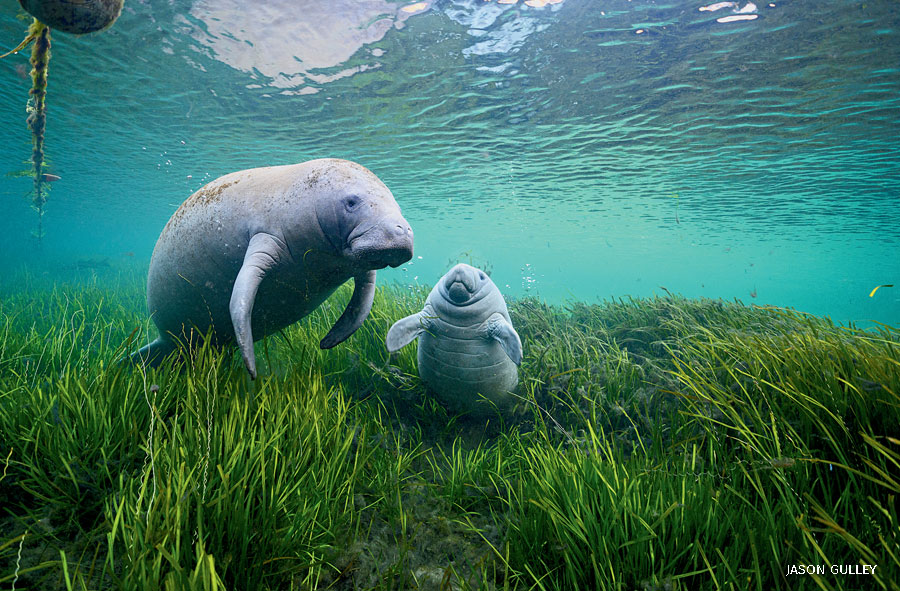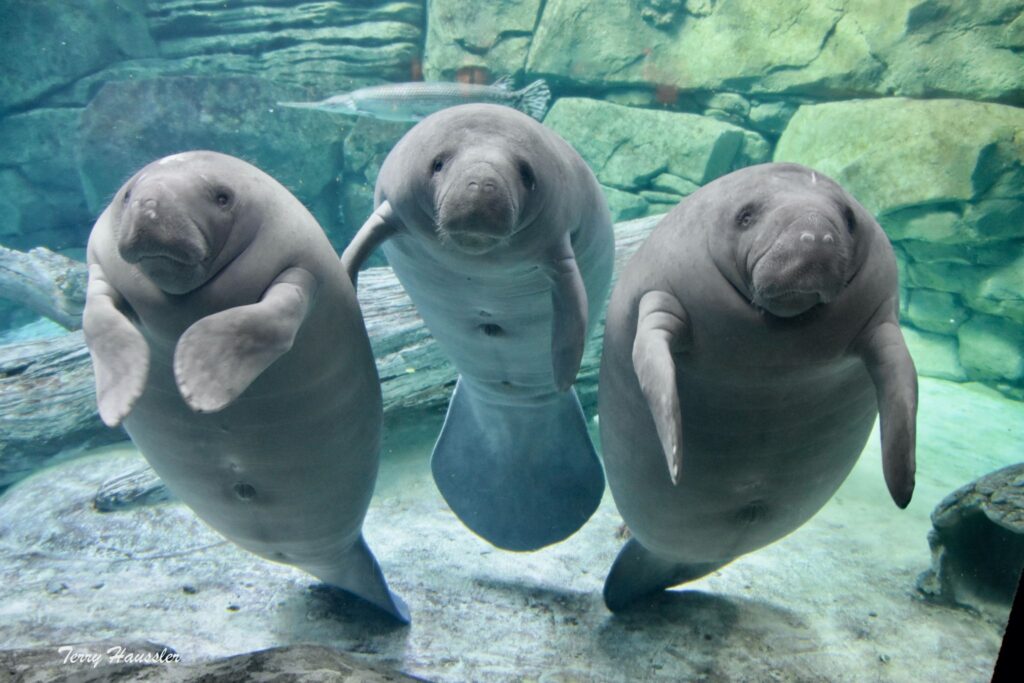Manatees
Manatees, often referred to as sea cows, are captivating marine mammals known for their gentle nature and serene presence in coastal waters and rivers. Belonging to the order Sirenia, along with dugongs and the now-extinct Steller’s sea cow, manatees are herbivorous creatures that play a vital role in the ecosystems they inhabit.

Taxonomic Classifications
Manatees belong to the order Sirenia, which is a group of aquatic mammals that includes manatees, dugongs, and the extinct Steller’s sea cow. Within the order Sirenia, there are three living species of manatees:
- West Indian Manatee (Trichechus manatus): This species is further divided into two subspecies:
- Florida Manatee (Trichechus manatus latirostris): Found in the southeastern United States, primarily in Florida.
- Antillean Manatee (Trichechus manatus manatus): Found in the Caribbean Sea and adjacent regions of the Atlantic Ocean.
- West African Manatee (Trichechus senegalensis): Found along the western coast of Africa, from Senegal to Angola, inhabiting coastal waters, estuaries, and rivers.
- Amazonian Manatee (Trichechus inunguis): Found in the freshwater habitats of the Amazon River basin in South America, including rivers, lakes, and flooded forests.
Characteristics and Habitat
Manatees are large, slow-moving creatures that can grow up to 13 feet (4 meters) in length and weigh as much as 1,300 pounds (590 kilograms). They have paddle-like flippers and a round, whiskered face that gives them a somewhat endearing appearance. Despite their size, manatees are remarkably graceful swimmers, capable of navigating shallow waters and moving between freshwater and saltwater environments.
These marine mammals primarily inhabit coastal waters, estuaries, and slow-moving rivers in tropical and subtropical regions around the world. They are commonly found in the warm waters of the Caribbean Sea, the Gulf of Mexico, the Amazon Basin, and West Africa, among other places. Manatees are herbivores, feeding on aquatic plants such as sea grasses, water hyacinths, and algae. Their diet requires them to consume large quantities of vegetation daily, which they efficiently digest with their complex stomachs.

Lifespan
Manatees have a relatively long lifespan compared to many other marine mammals. In the wild, they can live up to about 50-60 years. Their longevity is supported by their herbivorous diet and generally peaceful existence, free from natural predators in their habitats.
Mating Behavior
Manatees exhibit a polygamous mating behavior, where males compete for access to females during the breeding season.
Gestation Period
The gestation period for manatees lasts approximately 12 months. Females typically give birth to a single calf every 2-5 years. Mother manatees are highly nurturing and protective of their calves, who remain dependent on their mothers for about 1-2 years after birth.
Feeding habit and their behavior
Manatees are primarily herbivorous, feeding on a variety of aquatic plants such as sea grasses, water hyacinths, and algae. They are known to spend most of their time feeding, resting, and traveling in shallow coastal waters, rivers, and estuaries. Manatees are slow-moving and peaceful creatures, often seen basking in the sun near the water’s surface or leisurely swimming along the seabed.
Their communication involves a range of vocalizations and physical interactions, such as touching and rubbing against each other. Manatees are also known for their ability to navigate long distances in search of suitable habitats and food sources.

Population and Conservation Status
Manatees are protected under the Endangered Species Act and under the Marine Mammal Protection Act. Today, the range-wide population is estimated to be at least 13,000 manatees, with more than 6,500 in the southeastern United States and Puerto Rico (2024).
Climate change also poses a threat to manatees as rising water temperatures and changes in ocean currents can impact their food sources and habitats. Conservation organizations and governments collaborate on research, monitoring, and conservation efforts to mitigate these threats and ensure the long-term survival of manatee populations.
Significance and Cultural Impact
Manatees hold a special place in human culture and folklore. They have been depicted in art and literature for centuries, often symbolizing tranquility and harmony with nature. Indigenous cultures in regions inhabited by manatees sometimes incorporate these gentle creatures into their myths and spiritual beliefs, further emphasizing their cultural significance.
In modern times, manatees attract ecotourism, with enthusiasts and tourists eager to catch a glimpse of these marine mammals in their natural habitats. Responsible ecotourism practices aim to minimize disturbance to manatees while raising awareness about their conservation needs.

Some interesting facts about manatees
Herbivorous Diet: Manatees are strictly herbivorous marine mammals, feeding on a variety of aquatic plants such as sea grasses, water hyacinths, and algae. They can consume up to 10-15% of their body weight in vegetation daily.
Slow Moving: Manatees are known for their slow movements, typically swimming at speeds of 3-5 miles per hour (5-8 kilometers per hour). This leisurely pace helps conserve energy.
Warm-water Affinity: Manatees are found in warm, shallow waters of coastal areas, rivers, and estuaries. They cannot survive in water temperatures below 60°F (15.5°C) for extended periods.
Unique Respiratory Adaptations: Unlike other marine mammals, manatees have lungs that are positioned along their spine. They need to surface every few minutes to breathe air.
Highly Vocal: Manatees are surprisingly vocal animals, using a variety of sounds including squeaks, chirps, and squeals to communicate with each other. These vocalizations play a role in social interactions and mating behaviors.
Large Size: Adult manatees can reach lengths of up to 13 feet (4 meters) and weigh as much as 1,300 pounds (590 kilograms). Despite their size, they are generally docile and non-aggressive towards humans.
Long Lifespan: In the wild, manatees can live up to 50-60 years, making them one of the longest-living marine mammals.
Conservation Status: Manatees face numerous threats including habitat loss, boat collisions, and cold stress events. As a result, they are classified as vulnerable or endangered species in many regions.
Cultural Significance: Manatees have been depicted in various cultures throughout history and are often associated with themes of tranquility and environmental conservation.
Protection Efforts: Conservation efforts include the establishment of protected areas, regulations to reduce boat strikes, rescue and rehabilitation programs for injured or orphaned manatees, and public education campaigns to raise awareness about their conservation needs.

Conclusion
Manatees are remarkable creatures that inspire awe and admiration for their peaceful demeanor and ecological importance. As stewards of the environment, it is our responsibility to protect and conserve these gentle giants for future generations. Through collaborative efforts in research, conservation, and public awareness, we can ensure that manatees continue to thrive in the waters they call home, contributing to the biodiversity and beauty of our planet’s marine ecosystems.